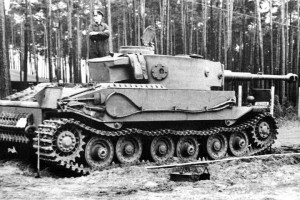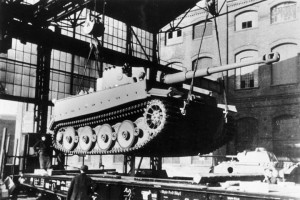Two companies, Henschel and Porsche, had been heavily involved in the design and development of previous heavy tank prototypes, and it was these two firms who presented their final versions of the Pz. Kpfw. VI at Hitler’s East Prussian retreat at Rastenburg on 20th April 1942, the Führer’s 53rd birthday.
Henschel versus Porsche
After much consideration the Henschel-built variant was selected as first choice, although ninety of the Porsche versions were also placed on order in case Henschel could not deliver. In the end, this proved not to be the case, as Henschel started to produce the new vehicles (designated Pz. Kpfw. VI Tiger Ausf. H) on schedule as promised.
Of the ninety planned Porsche Pz. Kpfw. VIs (given the Ausf. suffix P), only five were built to completion, and the remainder were later converted to tank-hunting (Panzerjäger) variants such as the Sd. Kfz. 184 Ferdinand (after the designer Ferdinand Porsche), although its crews were to dub it the Elefant, a name which was to become semi-official.
The Elefant proved to be a dismal failure, its defensive weaknesses being easily exploited by Soviet sappers and anti-tank guns. The Porsche model Tiger was easily distinguished from the production (Henschel) version by the more advanced positioning of the turret.
Soon after the first Pz. Kpfw. Ausf. H models were rolled off the production line, a number of completed prototypes were delivered to the German Army for trial, and by the early autumn of 1942 the first four fully-functional Tigers were delivered to 1. Kompanie schwere (heavy) Panzer Abteilung 502, which joined Army Group North in the area around Leningrad.
Strengths and weaknesses
The battlefield strengths of the 57-tonne (56-ton) Tiger I were essentially defined by the vehicle’s two major characteristics: its thick front hull and turret armour plate – which was in some places up to 100mm thick – and powerful 88mm L/56 KwK main gun.
In its early days of service, the Tiger’s opponents provided no real competition, and enemy tanks would have to close in to suicidal distances to even get a shot in. Even then they were not guaranteed to score a successful hit, with shells often bouncing harmlessly off the German Panzer’s thick front armour plate.
Conversely, the powerful gun mounted on the Tiger’s chassis could destroy opponents at massive distances. On the wide expanses of the Russian Front, these capabilities more than made up for the Tiger’s inherent weaknesses, which included its slow rate of turret traverse, lack of mobility and vulnerable rear and hull-top plate.
 |
 |
The Tiger’s disadvantages were revealed during the close-quarter battles in the West, where the crews had little opportunity to exercise the vehicle’s long-range firepower. Its thin turret- and hull-top armour was also particularly vulnerable to attacks by Allied rocket-armed aircraft such as the Hawker Typhoon and Tempest. Nevertheless, the Tiger was widely respected and feared right until the end of the war.
The 88mm L/56 KwK main gun was an adaptation of the successful anti-tank version of the famous ‘eighty-eight’ Flak gun. Mounted on the turret of the Tiger, the cannon was able to penetrate 112mm of armour at a distance of 1400 metres, and was capable of firing Armour Piercing (AP), High Explosive (HE) or High Explosive anti-tank (HEAT) rounds. Each Tiger was designed to carry 92 rounds of 88mm ammunition, of which about fifty percent were AP rounds, and was also equipped with two 7.92mm MG34 machine guns for use against infantry personnel and light vehicles.
The Waffen-SS formations would receive its first Tiger Is in the autumn of 1942, and the new vehicles saw significant action for the first time in early 1943. Having undergone extensive training with the Tiger I in the French town of Ploërmel following the completion of his officer training at Bad Tölz, SS-Untersturmführer Michael Wittmann would take command of the new vehicle as the leader of the IIIrd Platoon of the 13th schwere (heavy) Company in the late spring of 1943.
The Crew
The Pz. Kpfw. VI Tiger was manned by a crew of five, three of whom manned the turret and main gun:
Commander: The most important member of the crew, whose central role involved the sighting of targets and directing the other members of the crew from his rotating cupola situated at the left rear of the turret. The commander’s role called for high levels of concentration and co-ordination, attributes that were especially crucial during frenetic close-quarter combat.
Gunner: Located inside the cramped turret below and in front of the commander was the gunner, who was responsible for the traversal of the turret, the sighting of targets, and the firing of the 88mm L/56 KwK main gun. As well as the ability to handle the 88mm cannon, the gunner also needed to work effectively in conditions that could – quite literally – get pretty hot in combat situations.
Loader: Located on the right-hand side of the tank, the loader was responsible for the loading of the appropriate type of ammunition as specified by the gunner into the breech of the 88mm cannon. The task required dexterity and the ability to work quickly in a very confined space, as well as endurance to allow the gunner to carry out his task effectively.
Driver: Seated in the front of the hull on the left-hand side, it was the driver’s sole responsibility to manoeuvre the vehicle safely and co-ordinate effectively with the commander. In more experienced crews, the driver more often than not assisted the main gunner in locking onto targets by turning towards the face of the enemy – a technique that compensated for the slow rate of turret traverse.
Bow Machine Gunner/Radio Operator: Seated at the front of the hull to the right of the driver. As the title suggests, this crewman was both responsible for maintaining radio contact with other tanks in the platoon and HQ and for manning the the MG34 machine gun mounted in the front plate of the hull. This weapon was used to deal with non-armoured opponents, such as light vehicles and infantry.
